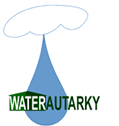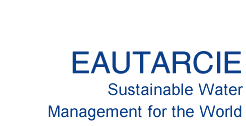
The considerations explained herein about the legal aspects of water utilization must be regarded as a concerned citizen's manifesto on water policies.
The following pages will be useful to water policy advisors and decision-makers, particularly in many parts of Europe and North America, as well as in those regions of the world that may be tempted to reproduce unsustainable supply and sanitation techniques. Arid and semi-arid regions of the world are traditionally and naturally more sensitive to the significance of rainwater harvesting, and it is to be hoped that official policies in these regions will be more in line with this concern: therefore, the considerations herein may (or may not) apply to those regions.
Managing one’s water as per the EAUTARCIE concept is more than a simple technical option: it is a social choice expressing a highly political standpoint. As such, the system’s prime quality is to conduce to a school of responsible management.
The text within this page was first published in French on www.eautarcie.com:
in 2003
The original text has since been adapted and was first published in English on this page at www.eautarcie.org:
2012-01-08
Last update: 2012-01-29


The PLUVALOR System and the Law
In France
Rainwater harvesting is not prohibited in France, but its use is regulated. Wherever a centralized water distribution system exists, the home is most often required to be connected to it.
Departmental Regulations
Some departmental regulations in France require households to keep the water meter on their mains water feed despite the fact that they use a different water supply (such as rain). They are not only required to maintain the meter, but also pay for it (monthly rental), even though their consumption of city water is nil. This constitutes a sort of illegal tax, disguised as a fee. Usually, a fee comes with a service. When city water consumption is nil and when the subscriber wishes to terminate the contract with his water provider, water supply should normally be cut off. Some departmental regulations thus represent an abuse by local authorities, because no legal text in France actually requires a home to be connected to the centralized water distribution network.
Fortunately, the private use of rainwater is not subject to authorization.
As an example, here is the official notice of SIVEER («Syndicat des eaux de la Vienne», a semi-public/semi-private water provider and sanitation cooperative drawing its water from the Vienne River in West Central France) on rainwater harvesting:
- "When a household is supplied by mains water as well as rainwater, a disconnector or air gap (between the two supply inlets) is mandatory".
- "Households choosing to have a rainwater harvesting system would be subject to significant costs due to existing regulatory constraints".
More explicitly: «A homeowner is obliged to inform authorities when using water other than that provided by a public service. If such water (in this case rainwater) generates a discharge of wastewater into the mains sewerage system, a sanitation fee is to be charged to the homeowner. City Hall has authority to determine the amount of the fee based on an estimated volume of water.»
Comments:
The first observation is quite logical. It expresses the desire to protect the water distribution network from contamination by water that does not comply with the law.
The second remark on regulatory constraints can only be logical in an absurd legal and regulatory context. Read more on the subject on Water Supply Policies.
Government Decree on rainwater harvesting in France, August 21 2008
Merchants who sell equipment for household water management must abide by the law, which requires the use of legally potable drinking water for all domestic uses. Moreover, the definition of «domestic» in the French legal system is not without ambiguity. A rigorous application of French law, prohibits anyone in this country from adopting the PLUVALOR system described in these pages.
Short of inciting the public to civil disobedience, I must point out the inconsistencies and inadequacies of water legislation. The second paragraph of Article No. 3 of the Decree of August 21, 2008 states: «The inside walls of the tank are to be constituted of materials that are inert with respect to rainwater». By «inert», this means materials that are chemically non reactive with water. By applying this law, the placement of concrete tanks should thus be prohibited.
This is a shame because rainwater that is stored in plastic or stainless steel tanks remains corrosive, fast becomes putrid, smelly and turns yellow. The alkaline components of concrete react with rainwater’s (very natural) acidity. The resulting chemical reaction neutralizes the acidity and provides a weak mineral uptake in the water (yet just right for optimal water quality). The law thus prohibits a technique that removes the corrosive nature of water (through chemical neutralization by concrete) and which ensures a light mineral content in water, essential for good biological quality.
Item 3 of the same article states: «The arrival of rainwater from the roof must go to the bottom of the storage tank.» Although technically feasible this is an unreasonable option. Unless equipped with an efficient calmed water inlet which prevents sediments in the tank from being disturbed, the influx of water during a heavy downpour will provoke sediment disturbance at the bottom of the tank, resulting in faster clogging of filters downstream. In addition, a tank bottom water inlet reduces the amount of useful aeration of the «falling water» from the roof, through the gutters, to the cistern. To spare one’s filters, and to obtain maximum water aeration (to oxygenate the water, giving it improved water quality), the tank inlet should be well above the tank’s water level.
Item 4 of Section III states: «Any system that allows the distribution of harvested rainwater within a building connected to the mains sewerage network is obliged to have a rainwater volume monitoring device». This aims to help assess the fee for wastewater discharge in the mains sewerage network, even if the water doesn’t come from the mains supply network.
In summary: this law essentially limits the use of rainwater to watering the garden and outdoor cleaning. For flush toilet tanks, officials counsel the sterilization of rainwater by UV irradiation! Whole house rainwater harvesting using the PLUVALOR system is thus strictly forbidden.
In Belgium
Fortunately, the legal situation in Belgium is quite different. This small country is at the forefront of progress in this field. A recent study has shown that in Belgium, with a population of ten million, more than 750,000 people use rain water for personal hygiene (brushing teeth, baths, showers) and more than 100,000 drink it (after proper filtration), and have been doing so for years.
However, lobbying from water management industries continues to exert pressure on policymakers. Contrary to what some local officials assert to developers, there is no legal obligation to connect one’s home to the water distribution network. In addition, centralized water providers’ authority stops at the home’s water meter (fortunately). What happens downstream of the meter is no longer under their jurisdiction. One can then adopt the PLUVALOR system, under one’s own responsibility. In Belgium, domestic water remains in the private domain, protected by the Constitution, in what can be considered as a fair and pragmatic approach. This is not the case in France.
On the other hand, supplying a home simultaneously with mains city water and stored rainwater is prohibited. This doesn’t mean that you need to double the piping in the home. For further reading on this subject, read the chapter on Implementing the PLUVALOR System.
Some municipalities offer incentives for the installation of a rainwater tank. One can only regret the fact that this is granted almost without conditions : you need only place a small tank of a few m³ to receive the bonus. Moreover, such an incentive should be reserved for installations with a tank whose capacity is calculated based on the home’s footprint. The guideline value would be 150 litres (33 gallons UK) of tank capacity per square meter of projected roof area.
In Belgium rainwater harvesting using the PLUVALOR system is not only permitted but recommended by more and more municipalities, especially in Brussels. This is becoming commonplace in other European countries also.




